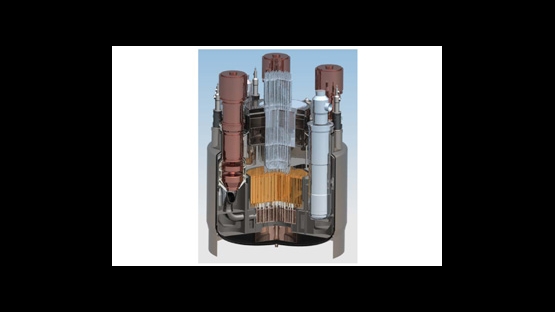Using currently known uranium resources, "fast reactors operating in a closed fuel cycle would be able to provide energy for thousands of years as well as easing concerns about waste," says Stefano Monti, Team Leader for the IAEA's Fast Reactor Technology Development Section in the Department of Nuclear Energy. Fast reactors are a versatile and flexible technology that promises to create or "breed" more fuel by converting nuclear "waste" into "fissile" material. "Fissile" material is nuclear fuel, usually uranium or plutonium that can sustain a fission chain. The heat generated by that fission chain reaction, contained within a nuclear power reactor, is used to produce steam, which then spins turbines to produce electricity. Since fast reactors "burn up" or consume material that would otherwise be considered "spent fuel", the total volume of nuclear material that needs to be handled as waste is reduced.
"Waste" Into Energy
The technology relies upon a "closed fuel cycle", which means that spent fuel is reprocessed after its initial use in a reactor. Instead of sending the spent fuel into storage and eventually long-term disposal, the materials are reused, in particular the "fertile" material. The "fertile" material is not fissionable, but it can be converted into fissionable material by exposure to radiation in a reactor. Once converted into fissile material, it will be consumed in the chain reaction. This conversion from "fertile" to "fissionable" material significantly improves nuclear fuel efficiency. Fast reactors can thus be used to breed more fissile material than they consume or to burn nuclear waste or for a combination of these two tasks. In short, they offer significant benefits in making nuclear energy production more sustainable.
"The fast breeder technology has the potential to make the production of energy from uranium 100 times more efficient than with the existing thermal reactor, reducing the amount and toxicity of radioactive waste, as well as the heat emanating from the waste, and also shortening the waste's hazardous lifetime span," says Monti.
International Conference
From 4 to 7 March 2013, more than 600 experts from 28 countries will be gathering in Paris for a four-day IAEA International Conference to review fast reactor and fuel cycle technology advances, safety, economic and proliferation-resistant related issues. This IAEA Conference is hosted by the Government of France through the French Alternative Energies and Atomic Energy Commission (CEA) and the French Nuclear Energy Society (SFEN), in cooperation with the OECD Nuclear Energy Agency (NEA).
The Conference provides a forum for the exchange of information about such new developments. It will also seek to identify gaps and key issues that need to be addressed towards the industrial-scale introduction of fast reactors, including public acceptance. As well, there will be a focus on engaging young people in innovative fast reactor and fuel-cycle development concepts.
Keynote addresses will be delivered by Laurent Michel, Director General of the French Ministry of Ecology, Sustainable Development and Energy; Yukiya Amano, Director General, IAEA (by video); Bernard Bigot, Chair of the French Alternative Energies and Atomic Energy Commission (CEA); and Yutaka Sagayama, vice-Chair of the Generation IV International Forum (GIF). The last IAEA-organized Fast Reactor Conference was held in Kyoto, Japan in 2009.
Strategic Planning
Fast breeder technology was developed in the 1960s with demonstration and prototype reactors operating in a number of countries, including China, France, Germany, India, Japan, the Russian Federation, the United Kingdom and the United States. There are 12 experimental fast reactors and six commercial size prototypes with outputs from 250 - 1200 MW that have been constructed or are in operation. The Russian Federation currently operates the most powerful commercial fast reactor, the BN-600 in Beloyarsk, and is constructing the BN-800. It recently launched a "Federal Target Programme" entitled New Generation Nuclear Power Technologies for 2010-2015 With Outlook to 2020, aimed at the development of several fast reactor technologies as well as related fuel cycles. There are programmes to develop and implement innovative fast nuclear energy systems in China, France, India, Japan, the Republic of Korea, the Russian Federation, among other countries. In Europe, a strategy and technological pathway for fast reactors includes the development of a sodium cooled fast reactor as a first track, aligned with Europe's prior experience, and two alternative fast reactor technologies to be explored on a longer timescale: lead cooled fast reactors and gas cooled fast reactors. And a number of initiatives, including the Generation IV International Forum and the IAEA's International Project on Innovative Nuclear Reactors and Fuel Cycles (INPRO), are continuing research on fast reactor technology. Experts expect that the first Generation IV fast reactor demonstration plants and prototypes will be in operation by 2030 to 2040.


